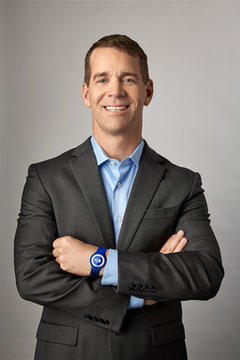ocean medallion: out with the old and in with the new
Frances Marcellin sailed around the British Isles with Princess Cruises to try out Carnival’s Ocean Medallion – a wearable accessory that tracks passengers and offers personalised services - for the first time. below, she recounts her experience.
W
hen I stepped on board Crown Princess in September 2019, it was 13 years since Princess Cruises had launched her into the fleet. I’d just arrived in the renowned Italian piazza-style atrium – thinking over whether to have a clip or a necklace to carry my Ocean Medallion – when I realised that it was the first time I had been on a smart ship that wasn’t a brand-new vessel.
I was on an older ship, with a capacity for 3,080 guests, yet at the same time on one of the most innovative ships in the world.

freelance journalist for future cruise frances marcellin
Image: Princess Cruises
When I mentioned this realisation to Carnival's chief experience and innovation officer John Padgett, he told me that it had widely been the perception of the media and cruise industry that you can only innovate on a new ship.
“It is definitely not our perspective at all,” he said, adding that any ship of any size can go into the dry dock and come out as “the smartest city in the world”.
Just two-and-a-half years earlier, Carnival Corporation CEO Arnold Donald unveiled the Ocean Medallion at the Consumer Electric Show (CES) in Las Vegas.
A wearable device the size of a 10p coin, he announced it would provide a seamless personalised experience to passengers through a unique Internet of Things (xIoT TM ) platform. Ocean Medallion launched on board Princess Cruises’ Caribbean Princess in August 2018 and was activated on four more ships in 2019, including Crown Princess with six ships planned for 2020.

Carnival’s chief experience and innovation officer john padgett
Image: Princess Cruises
Viking Cruises hotel general manager Joachim Scherz.
The Crown Princess was launched in 2006 and last modernised in 2018.
Image: Princess Cruises
The Crown Princess was launched in 2006 and last modernised in 2018
Image: Princess Cruises
After just a ten-day drydock in the Bahamas – part of Princess Cruises’ $450m “Come Back New” campaign – it featured the xIoT patented system. The new infrastructure required 72 miles of cable, 4,000 sensors, 650 readers, 500 edge computing devices and more than 4,000 interactive portals.
At the same time, the ship was also upgraded with new dining venues, kids’ and spa areas and installed the Princess Luxury Bed in almost every stateroom.
personalisation
for every passenger
Putting the technology aside, I admired the expensive, high-quality look of the Ocean Medallion that was engraved with my full name. It is the perfect souvenir, original and free for guests, a clever design that is partly responsible for the 99.7% guest acceptation rate of the Ocean Medallion.
Combining an almost 100% passenger take-up without requiring a smartphone to make it work is behind the power of the system.
It is personalised to the guest, you don’t have to charge it or configure it, there aren’t any settings, it is waterproof, and there’s no on and off button
“It all goes back to our core strategy, which is, what Medallion Class is built to do, increase the personalisation and simplicity of the vacation experience for every single person on that ship,” explains Padgett, adding that the componentry inside the medallion is “remarkably similar” to a smartphone.
Inside, microelectronics power two microscopic antennas, one for near-field communication (NFC) and one for Bluetooth Low Energy (BLE). The readers and sensors across the ship interact with guests’ Medallions.
Viking Cruises hotel general manager Joachim Scherz.
Through OceanCompass, passengers can access personalised information, such as suggestions for activities, via their mobile device.
Image: Princess Cruises
Image courtesy of MSC Cruises
“It is personalised to the guest, you don’t have to charge it or configure it, there aren’t any settings, it is waterproof, and there’s no on and off button,” says Padgett, who stresses that because of the hardware and operating system variations, there is “actually no way to use a mobile phone to provide a ubiquitous experience to all guests”.
“It’s really next level,” he says. “For guests to be fully connected from their home, all the way through to the port on the ship, horizontally across every single vertical, restaurant, bars, recreation, entertainment, everything is staged on our experience platform, they only have to interact with us in one way.”
The system does offer interactive games through PlayOcean and wager-based gaming with Ocean Casino, but its effective practical features are what enhances the passenger experience onboard and eliminates time-consuming activities, such as queueing. These include fast “expedited” arrival with OceanReady (personalisation before the cruise at home); the friends and family locator and onboard wayfinding with OceanCompass; and easy payment.
two-factor identification
and data safety
Every ship offering the Ocean Medallion experience provides a high level of security through two-factor authentication (2FA). “Effectively we have two-factor identification on everything,” says Padgett, adding that the crew at every interaction point - NFC triggers the Medallion you’re carrying - is aware of your security profile, which includes an ID number and a picture of your face. “Thus, those two are always matched on every single interaction, which makes it a much more secure and safe environment from a safety perspective,” he says.
Passengers also do not need to worry that details about their identity are stored on the Medallion.
“Traditional cruise cards are like billboards, they have all kinds of information on them, if you know what you’re looking at, whereas the Ocean Medallion only has the most minimal information required,” he says.
Passenger do not need to worry that details about their identity are stored on the Medallion
“The name is laser-etched on it, as that’s what the various regulatory and government agencies require for it to go in and out of the ports, but other than that we don’t have any of that other information.”
He adds: “The medallion itself is nothing more than carrying a meaningless licence plate that is encrypted so even if anyone could ever break the encryption, it would be meaningless to them, they could do nothing with it.”
Image courtesy of MSC Cruises
EXPERIENCING THE GROUND BREAKING OCEANNOW
One of the features I had been particularly looking forward to trying out was OceanNow. Could I really order food and drink from my smartphone and have it delivered to me anywhere? As I moved through the vessel, depending on what ‘zone’ I was in, the app showed me what food service I could order from.
Anything on that ship, any service you want, anytime you want it, anywhere you want it, is on-demand for you – that’s the ethos of it
I ordered a hotdog, chips and a Coke inside and then walked to one of the poolside benches on deck to watch a jazz concert that was being screened over the pool. Ten minutes later a waiter carrying my order located me and greeted me by name. I didn’t have to go anywhere or give up my excellent seat to find food; it found me.
Viking Cruises hotel general manager Joachim Scherz.
OceanNow allows passengers to order food and drink to their location.
Image: Princess Cruises
The fact that this action is possible on a cruise ship is absolutely ground-breaking. I didn’t need to explain anything to anyone. I’d ordered food from a location, moved to another and the food arrived promptly.
Right now OceanNow is in its earliest form but in the future I won’t be restricted by the ‘zones’ inside or by what I can order. “People confuse OceanNow with food and drink delivery tied to a location, but it’s the opposite,” explains Padgett.
“It is actually any time, any place service on demand, so it’s essentially the service delivery model upside down,” he continues. “Anything on that ship, any service you want, anytime you want it, anywhere you want it, is on demand for you – that’s the ethos of it.”
cruising on the edge (computing)
One of the most impressive aspects of the services I was using during my cruise on Crown Princess was the speed the system worked at. This is due to edge computing, which optimises network performance and reduces latency.
“Medallion Class and the Ocean experience platform, from our knowledge, is probably the best example of Edge computing in IoT in the world as relates to humans,” says Padgett. “We have 7,000 sensors, 4,000 digital displays, and they’re in the door portals, elevators, lobbies, stateroom, and all that information is lightning-fast because there are specialised edge computers that are proprietary to us.”
The premise of the platform is to reinvest the information generated in real-time back to the guest experience
The sensors, edge computers, computing facilities on the ship, main data centres (onboard), the cloud and some shoreside data, all stay synchronised.
Viking Cruises hotel general manager Joachim Scherz.
Image: Princess Cruises
“The premise of the platform is to reinvest the information generated in real-time back to the guest experience and that can only be done when your computing is on the edge,” says Padgett, adding that running a fully connected edge computer infrastructure and cloud structure in real-time on the edge is one of the biggest challenges that the team has faced. “We make it look simple, but it is extremely complex,” he stresses.
While the OceanNow-ordered poolside lunch was the most remarkable aspects of the Ocean Medallion experience, the most surprisingly satisfying was how the Medallion automatically opened my stateroom door. I had underestimated the effect this particular feature would have. I often walk back to my cabin with my arms full, so it was certainly a practical advantage that the door opened as I approached.
But, as the digital reader outside my door showed my name and photograph, it provides a VIP-type feeling and personalised my experience further – overall its impact is greater than the sum of its parts.
“It is our highest commented-on experience – it even celebrates your birthday,” Padgett tells me. “What’s so unique about it is that before this creation, the door would not have been considered as part of your experience, it’s completely unremarkable. But we were passionately committed to eliminating friction throughout the experience.”
In the long run, Carnival intends to provide a 100% frictionless experience across every ship in the fleet. “Every time you come back we will be further and further along, but it’s a journey,” he says.